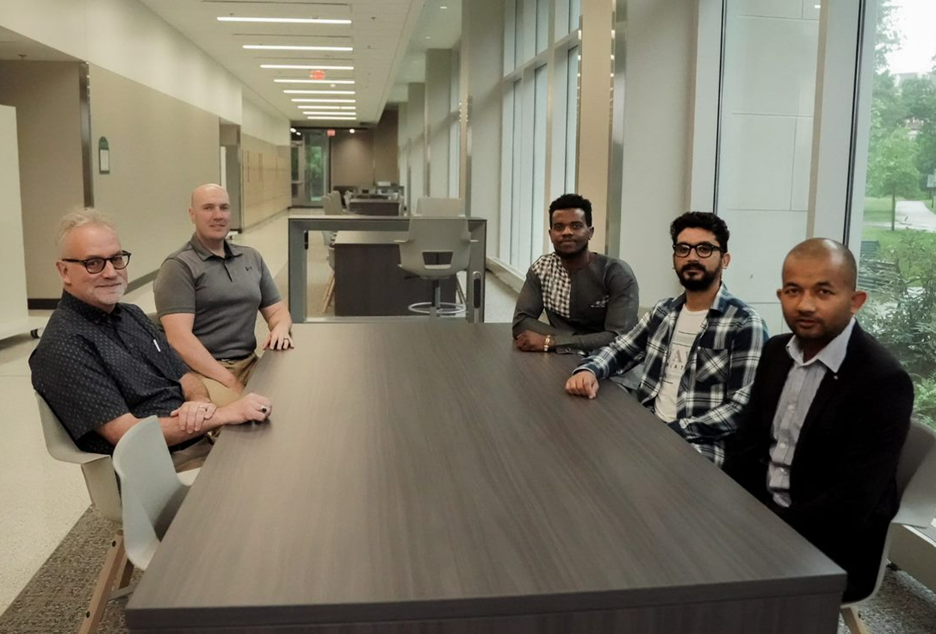Researchers from Ohio University presented evidence for a new carbon solid called “amorphous graphite” this week, as the world’s need for carbon-based materials, like graphite, increases.
 (left side of table, front to back) Distinguished Professor of Physics David Drabold, Russ Professor of Engineering Jason Trembly; (right side of table, front to back) doctoral students Rajendra Thapa, Kishor Nepal, Chinonso Ugwumadu. Image Credit: Ohio University.
(left side of table, front to back) Distinguished Professor of Physics David Drabold, Russ Professor of Engineering Jason Trembly; (right side of table, front to back) doctoral students Rajendra Thapa, Kishor Nepal, Chinonso Ugwumadu. Image Credit: Ohio University.
“Can we make graphite from coal?” asked physicist David Drabold and engineer Jason Trembly.
Researchers state in their research, “Graphite is an important carbon material with many uses. A burgeoning application for graphite is for battery anodes in lithium-ion batteries, and it is crucial for the electric vehicle industry—a Tesla Model S on average needs 54 kg of graphite. Such electrodes are best if made with pure carbon materials, which are becoming more difficult to obtain owing to spiraling technological demand. Ab initio simulation of amorphous graphite.”
This study was published in the journal Physical Review Letters.
Their effort is ab initio, which means “from the beginning,” and it aims to find new ways to synthesize graphite from naturally existing carbonaceous materials. With numerous different computations, researchers discovered a layered material that develops at extremely high temperatures (about 3000 °K).
Its layers stick together because an electron gas forms between them, but they are not the exact hexagonal layers that make up ideal graphene. There are a lot of hexagons in this new material, but there are also pentagons and heptagons. The new material’s electrical conductivity is lower than graphene because of the ring disorder, but it is still high in the regions dominated by hexagons.
Not All Hexagons
In chemistry, the process of converting carbonaceous materials to a layered graphitic structure by thermal treatment at high temperature is called graphitization. In this letter, we show from ab initio and machine learning molecular dynamic simulations that pure carbon networks have an overwhelming proclivity to convert to a layered structure in a significant density and temperature window with the layering occurring even for random starting configurations.
David Drabold, Distinguished Professor, Physics and Astronomy, College of Arts and Sciences, Ohio University
“The flat layers are amorphous graphene: topologically disordered three-coordinated carbon atoms arranged in planes with pentagons, hexagons and heptagons of carbon. Since this phase is topologically disordered, the usual ‘stacking registry’ of graphite is only statistically respected,” Drabold noted.
Drabold also explained, “The layering is observed without Van der Waals corrections to density functional (LDA and PBE) forces, and we discuss the formation of a delocalized electron gas in the galleries (voids between planes) and show that interplane cohesion is partly due to this low-density electron gas. The in-plane electronic conductivity is dramatically reduced relative to graphene.”
Exfoliation and/or experimental surface structure probes may be used to screen for the presence of amorphous graphite, which the researchers hope will drive experimentation and investigations.
Jason Trembly, the Russ Professor of Mechanical Engineering and Director of the Institute for Sustainable Energy and the Environment at Ohio University’s Russ College of Engineering and Technology, has been researching green coal applications.
In the study, Trembly and Drabold partnered with physics Ph.D. students Rajendra Thapa, Chinonso Ugwumadu, and Kishor Nepal. Drabold is also a member of OHIO’s Nanoscale & Quantum Phenomena Institute, where he has authored several studies on the theory of amorphous carbon and amorphous graphene. Drabold also praised his graduate students for their hard work in conducting this study.
Surprising Interplane Cohesion
The question that led us to this is whether we could make graphite from coal. This paper does not fully answer that question, but it shows that carbon has an overwhelming tendency to layer—like graphite, but with many ‘defects’ such as pentagons and heptagons (five- and seven-member rings of carbon atoms), which fit quite naturally into the network.
David Drabold, Distinguished Professor, Physics and Astronomy, College of Arts and Sciences, Ohio University
“We present evidence that amorphous graphite exists, and we describe its process of formation. It has been suspected from experiments that graphitization occurs near 3,000K, but the details of the formation process and nature of disorder in the planes was unknown,” Drabold added.
The work of the Ohio University researchers also predicts a new carbon phase.
Until we did this, it was not at all obvious that layers of amorphous graphene (the planes including pentagons and heptagons) would stick together in a layered structure. I find that quite surprising, and it is likely that experimentalists will go hunting for this stuff now that its existence is predicted.
David Drabold, Distinguished Professor, Physics and Astronomy, College of Arts and Sciences, Ohio University
“Carbon is the miracle element—you can make life, diamond, graphite, Bucky Balls, nanotubes, graphene, and now this. There is a lot of interesting basic physics in this, too—for example how and why the planes bind, this by itself is quite surprising for technical reasons,” Drabold concluded.
New Carbon Solid: Amorphous Graphite
The process of layer formation: starting with 1,000 randomly selected initial coordinates, the model was annealed at 3,000 K, and layers after 60 ps (1 ps = 10-12 second). Colors: green represents two coordinated atom, blue one, yellow three, red four. The layers emerging at the end are planes of amorphous graphene. Video Credit: Ohio University.
Journal Reference:
Thapa, R., et al. (2022) Ab Initio Simulation of Amorphous Graphite. Physical Review Letters. doi.org/10.1103/PhysRevLett.128.236402.